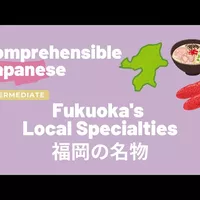Fukuoka 's Local Specialties 福岡 の 名物 - Intermediate Japanese 日本 語 中級
fukuoka||local|specialties|ふくおか||めいぶつ|intermediate|japanese|にっぽん|ご|ちゅうきゅう
Fukuokas Spezialitäten||lokal|Spezialitäten|Fukuoka||Spezialitäten|||||Mittelstufe
Lokale Spezialitäten aus Fukuoka Fukuoka-Spezialitäten - Japanisch für Fortgeschrittene
Fukuoka's Local Specialties - Intermediate Japanese
Les spécialités locales de Fukuoka Les spécialités de Fukuoka - Niveau intermédiaire en japonais
Fukuoka's lokale specialiteiten Fukuoka's specialiteiten - Japans voor gevorderden
私 は 日本 の 福岡 と いう 街 に 住んで います 日本 に は 北海道 、本州 、四国 、九州
わたくし||にっぽん||ふくおか|||まち||すんで||にっぽん|||ほっかいどう|ほんしゅう|しこく|きゅうしゅう
Ich||||Fukuoka||genannt|Stadt||wohne in|lebe in||||Hokkaido|Honshu-Insel|Shikoku-Insel|Kyushu
Ich lebe in der Stadt Fukuoka in Japan. In Japan gibt es Hokkaido, Honshu, Shikoku und Kyushu.
I live in a city called Fukuoka in Japan, which consists of Hokkaido, Honshu, Shikoku, and Kyushu.
と 4つ の 島 が あります が 、私 が 住んで いる 福岡 は 九州 に あります ここ が 福岡 です
|||しま||||わたくし||すんで||ふくおか||きゅうしゅう|||||ふくおか|
|||Insel||||||||Fukuoka||Kyushu-Insel||gibt es|||Fukuoka|
Es gibt vier Inseln, aber Fukuoka, wo ich lebe, liegt auf Kyushu. Hier ist Fukuoka.
And there are four islands, but Fukuoka, where I live, is in Kyushu. This is Fukuoka.
福岡 は 九州 の 中 で は 一 番 人口 が 多い 街 です そして おいしい 食べ物 が たくさん ある 街 として 有名です
ふくおか||きゅうしゅう||なか|||ひと|ばん|じんこう||おおい|がい||||たべもの||||まち|と して|ゆうめい です
|||||||||Bevölkerung||zahlreich|Stadt||||||||Stadt|als|bekannt für
Fukuoka ist die bevölkerungsreichste Stadt in Kyushu und bekannt für viele leckere Speisen.
Fukuoka is the most populous city in Kyushu and is famous as a city with lots of delicious food.
福冈是九州地区人口最多的城市,也是以美食闻名的城市。
日本 国内 でも 美味しい 食べ物 を 目当て に 福岡 に 旅行 に 来る 人 が とても 多い です 今日 は 写真 を 見 ながら
にっぽん|くに ない||おいしい|たべもの||めあて||ふくおか||りょこう||くる|じん|||おおい||きょう||しゃしん||み|
|im Inland Japans|auch in|lecker|Essen||im Hinblick auf||Fukuoka||Reise nach Fukuoka||nach Fukuoka kommen||||sehr viele||||Fotos ansehen|||während
Even in Japan, there are a lot of people who come to Fukuoka for a trip to eat delicious food. Today, while looking at the photos
日本国内有很多人是因为美味的食物而来福冈旅行的。今天就边看照片边说吧。
福岡 の 有名な 食べ物 、福岡 の "名物 "を 紹介 したい と 思います まず 1枚 目 の 写真 を 見て ください
ふくおか||ゆうめいな|たべもの|ふくおか||めいぶつ||しょうかい|||おもいます||まい|め||しゃしん||みて|
||berühmte||Fukuoka||Spezialität||vorstellen|möchte vorstellen||denke ich|Zunächst|Seite|Bild||Foto|||
I'd like to introduce Fukuoka's famous food, Fukuoka's "specialties" First, please look at the first photo.
我想介绍一下福冈著名的美食,福冈的“名物”。请看第一张照片。
これ は "もつ鍋 "と いいます もつ 鍋 と いう 名前 の 鍋 料理 です
||もつ なべ||||なべ|||なまえ||なべ|りょうり|
||Eintopf mit Innereien|||Innereien|Eintopfgericht||genannt wird|Name||Eintopfgericht|Gericht|ist
This is called "motsu nabe," a hot pot dish named "motsu nabe.
スープ の 中 に 野菜 と ”もつ ”が 入って います ”もつ ”というのは 豚 や 牛 や 鳥 の 内臓 の こと です
すーぷ||なか||やさい||||はいって|||と いう の は|ぶた||うし||ちょう||ないぞう|||
Suppe||||Gemüse||Innereien|||||bedeutet|Schwein||Rindfleisch||Geflügel|von|Innereien|||
The soup contains vegetables and "motsu". "Motsu" refers to the internal organs of pigs, cows and birds.
心臓 や 肝臓 や 腸 の こと です これ を 鍋 に 入れて グツグツ 煮込んで 食べます
しんぞう||かんぞう||ちょう||||||なべ||いれて||にこんで|たべます
Herz||Leber||Darm||||||Eintopf||hineinlegen|köcheln|kochen|
It's the heart, the liver and the intestines, and you put them in a pot, simmer them down, and eat them.
スープ の 味 は 醤油 味 や 味噌 味 や 塩味 など 色々な 種類 が あります 私 は 実は 、もつ 鍋 は あんまり 好きじゃ ありません
すーぷ||あじ||しょうゆ|あじ||みそ|あじ||しおあじ||いろいろな|しゅるい|||わたくし||じつは||なべ|||すきじゃ|
||Geschmack||Sojasauce|Geschmack||Miso-Geschmack|Geschmack||Salzgeschmack|und so weiter|verschiedene|Arten|||||Tatsächlich|Innereien|Eintopf||nicht wirklich|mag nicht|mag nicht
Der Geschmack der Suppe variiert je nach Art, wie Sojasoße, Miso oder Salz. Ich mag eigentlich nicht so sehr Innereien-Nabe.
The soup comes in a variety of flavors, such as soy sauce, miso, and salt.Actually, I don't really like motsunabe.
もつ が 苦手な ので あんまり 食べた こと が ありません 次の 写真 を 見ましょう
||にがてな|||たべた||||つぎの|しゃしん||みましょう
Innereien||nicht gut mit||nicht wirklich|gegessen habe||||nächste|Foto||Schauen wir mal
Da ich Innereien nicht mag, habe ich nicht oft davon gegessen. Lass uns das nächste Foto ansehen.
I'm not a big fan of taro, so I haven't had much of it, but let's take a look at the next picture.
これ は "水炊き "です 水 炊き も 先ほど 紹介 した もつ 鍋 と 同じく 鍋 料理 です
||みずたき||すい|たき||さきほど|しょうかい|||なべ||おなじく|なべ|りょうり|
||Wasserkochen Eintopf|||Kochen||vorhin|vorgestellt|vorgestellt habe|Innereien|Eintopfgericht||ebenso wie|Eintopfgericht|Gericht|ist
Das ist "Suiyaki", ein Topfgericht ähnlich wie das zuvor vorgestellte Innereien-Nabe
This is "mizutaki," which is a one-pot dish similar to the "mozutsu nabe" introduced earlier.
鍋 に 鶏肉 と 野菜 を 入れて 煮込んだ 料理 です 鶏肉 の だし の スープ が とって も 美味しい です
なべ||けいにく||やさい||いれて|にこんだ|りょうり||けいにく||||すーぷ||||おいしい|
Eintopf||Hühnerfleisch||Gemüse||hinzugeben|gekocht|Gericht||Hühnerfleisch||Hühnerbrühe||Brühe||sehr||sehr lecker|
It is a dish made by stewing chicken and vegetables in a pot with chicken broth.
これ は ”辛子明太子 ”と いいます これ 、何 だ と 思います か
||しん こ あきたいし||||なん|||おもいます|
||Scharfer Pollackrogen|||||||glauben Sie|
Das hier heißt 'Karinashi Mentaiko'. Was denkst du, was das ist?
This one is called "Shin Zi Ming Tai Zi." What do you think this is?
実は これ は "スケトウダラ "と いう 名前 の 魚 の 卵 から できて います
じつは||||||なまえ||ぎょ||たまご|||
Tatsächlich|||Seelachsrogen|||||||Fischeier||aus gemacht|
Tatsächlich wird es aus den Eiern eines Fisches namens 'Kohlrutschen' hergestellt.
It is actually made from the eggs of a fish named "Alaska Pollack."
スケトウダラ の 卵 を 唐辛子 など で 味付け した もの です "辛子 "明 太子 と いう 名前 の 通り
||たまご||とうがらし|||あじつけ||||からし|あき|たいし|||なまえ||とおり
Pollackrogen||||Chilischoten||||||||||||||
Es handelt sich um mit rotem Pfeffer und anderen Zutaten gewürzte Kohlrutschen-Eier, wie der Name 'Karinashi Mentaiko' suggeriert.
The roe of Alaska Pollack is seasoned with chili peppers and other seasonings, just as the name "spicy cod" implies.
辛い です 辛い けど 美味しい です こんな 風 に 白 ご飯 の 上 に 載せて 食べる と とって も 美味しい です
からい||からい||おいしい|||かぜ||しろ|ごはん||うえ||のせて|たべる||||おいしい|
It's spicy, but it's delicious. It's very delicious when you eat it over white rice like this.
辛 子 明 太子 の おにぎり や 辛 子 明 太子 の パスタ など も あります これ は ラーメン です 私 の 大好きな ラーメン です
しん|こ|あき|たいし||||しん|こ|あき|たいし||ぱすた||||||らーめん||わたくし||だいすきな|らーめん|
There are also spicy cod roe onigiri and spicy cod roe pasta, etc. This is ramen, my favorite kind of ramen.
日本 に は 色々な 種類 の ラーメン が あります 地域 ごと に スープ の 味 や 麺 が 違います
にっぽん|||いろいろな|しゅるい||らーめん|||ちいき|||すーぷ||あじ||めん||ちがいます
There are many kinds of ramen in Japan, and the flavor of the soup and the noodles differ from region to region.
スープ に は 醤油 味 や 味噌 味 、塩味 など が あります 麺 に は まっすぐな ストレート 麺 や
すーぷ|||しょうゆ|あじ||みそ|あじ|しおあじ||||めん||||すとれーと|めん|
Soups include soy sauce, miso and salt flavored soups, and noodles can be straight or salty.
縮れ 麺 、太い 麺 、細い 麺 など が あります
ちぢれ|めん|ふとい|めん|ほそい|めん|||
福岡 の ラーメン は 豚 の 骨 から とった 豚 骨 スープ に 細くて まっすぐな 麺 が 入って いる の が 特徴 です
ふくおか||らーめん||ぶた||こつ|||ぶた|こつ|すーぷ||ほそくて||めん||はいって||||とくちょう|
Fukuoka's ramen is characterized by thin, straight noodles in a tonkotsu soup made from pork bones.
これ は うどん です うどん も 先程 の ラーメン と 同じ 、麺 料理 です
||||||さきほど||らーめん||おなじ|めん|りょうり|
This is udon. Udon is a noodle dish, just like the ramen I mentioned earlier.
うどん も 全国 どこ でも 食べられる 料理 です が 福岡 の うどん は 麺 が 柔らかい の が 特徴 です
||ぜんこく|||たべられる|りょうり|||ふくおか||||めん||やわらかい|||とくちょう|
Udon is a dish that can be eaten anywhere in the country, but Fukuoka's udon is characterized by its soft noodles.
そして 福岡 の うどん と いえば この "ごぼ天うどん "です "ご ぼ 天 "と は ごぼう の 天ぷら の こと です
|ふくおか||||||ご ぼ てん うどん||||てん|||||てんぷら|||
And speaking of udon in Fukuoka, it's this "goboten udon." "Goboten" is burdock tempura.
ごぼう と いう 野菜 を 知っています か こんな 風 に 土 の 中 で 育つ 茶色くて 細長い 野菜 です
|||やさい||しっています|||かぜ||つち||なか||そだつ|ちゃいろくて|ほそながい|やさい|
Do you know a vegetable called burdock? It's a long, brown vegetable that grows in the soil like this.
この ごぼう の 天ぷら が のった ご ぼ 天 うどん が 有名です 私 も ご ぼ 天 うどん が 大好きです
|||てんぷら|||||てん|||ゆうめいです|わたくし||||てん|||だいすきです
福岡 に は 他 に も おいしい 食べ物 が たくさん あります 果物 で 有名な の は いちご です
ふくおか|||た||||たべもの||||くだもの||ゆうめいな||||
Fukuoka is home to many other delicious foods, the most famous of which are strawberries.
実 が 大きくて 真っ赤で 、甘くて とても おいしい です それ から 福岡 は 海 が 近い ので 魚 や イカ や 牡蠣 など 海の幸 も 有名です
み||おおきくて|まっかで|あまくて||||||ふくおか||うみ||ちかい||ぎょ||いか||かき||うみ の さち||ゆうめいです
The fruits are large, bright red, sweet and very delicious.Furthermore, since Fukuoka is near the sea, seafood such as fish, squid and oysters are also famous.
海 で 採って すぐ 、採れたて の 新鮮な 魚介 類 が 食べられます
うみ||とって||とれ たて||しんせんな|ぎょかい|るい||たべられます
You can eat freshly caught seafood as soon as it is caught in the sea
紹介 した 中 で 食べた こと が ある 食べ物 は ありました か
しょうかい||なか||たべた||||たべもの|||
Have you tried any of the foods introduced?
一 番 食べて みたい と 思った もの は どれ でした か
ひと|ばん|たべて|||おもった|||||
Which one did you want to eat the most?
今日 は 福岡 の 有名 の 食べ物 、福岡 の 名物 を 紹介 しました
きょう||ふくおか||ゆうめい||たべもの|ふくおか||めいぶつ||しょうかい|
今日 は これ で おしまい
きょう||||
また ね!

